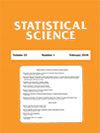协变量校正ROC曲线:概念及其重要性,推理方法综述,以及一种新的贝叶斯估计量
IF 3.9
1区 数学
Q1 STATISTICS & PROBABILITY
引用次数: 5
摘要
准确诊断疾病在临床实践和医学研究中具有重要意义。在医学诊断测试被常规应用于实践之前,必须严格评估其区分疾病和非疾病状态的能力。受试者工作特性(ROC)曲线是评估连续结果测试诊断准确性的最常用工具。人们已经认识到,有几个因素(例如,受试者的特定特征,如年龄和/或性别)会影响疾病状态之外的测试结果和准确性。最近,协变量调整的ROC曲线被提出并成功应用于考虑协变量信息的诊断准确性的全局汇总测量。本文的目的有三个方面。首先,我们强调了在ROC分析中尽可能包含协变量信息的重要性,特别是协变量调整的ROC曲线在这种情况下是如何成为一个重要工具的。其次,我们回顾并深入了解现有的估计协变量调整ROC曲线的方法。第三,我们开发了一种高度灵活的贝叶斯方法,基于加性正态模型的狄利克雷过程混合和贝叶斯自举,用于对协变量调整的ROC曲线进行推断。进行了一项模拟研究来评估不同方法的性能,它还证明了我们提出的贝叶斯模型能够成功恢复真正的协变量调整ROC曲线,并在各种复杂场景中产生有效的推断。这些方法应用于内分泌研究,目的是评估根据年龄和性别调整的体重指数的准确性,以检测心血管疾病风险因素。关键词:分类准确性;协变量调整;决策阈值;诊断测试;狄利克雷过程(混合物)模型;接收器工作特性曲线。Vanda Inácio,英国苏格兰爱丁堡大学数学学院(vanda.inacio@ed.ac.uk)。西班牙巴斯克国家毕尔巴鄂巴斯克科学基金会,BCAM巴斯克应用数学中心和IKERBASQUE(mxrodriguez@bcamath.org)。本文章由计算机程序翻译,如有差异,请以英文原文为准。
The Covariate-Adjusted ROC Curve: The Concept and Its Importance, Review of Inferential Methods, and a New Bayesian Estimator
Accurate diagnosis of disease is of fundamental importance in clinical practice and medical research. Before a medical diagnostic test is routinely used in practice, its ability to distinguish between diseased and nondiseased states must be rigorously assessed. The receiver operating characteristic (ROC) curve is the most popular used tool for evaluating the diagnostic accuracy of continuous-outcome tests. It has been acknowledged that several factors (e.g., subject-specific characteristics such as age and/or gender) can affect the test outcomes and accuracy beyond disease status. Recently, the covariate-adjusted ROC curve has been proposed and successfully applied as a global summary measure of diagnostic accuracy that takes covariate information into account. The aim of this paper is three-fold. First, we motivate the importance of including covariate-information, whenever available, in ROC analysis and, in particular, how the covariate-adjusted ROC curve is an important tool in this context. Second, we review and provide insight on the existing approaches for estimating the covariate-adjusted ROC curve. Third, we develop a highly flexible Bayesian method, based on the combination of a Dirichlet process mixture of additive normal models and the Bayesian bootstrap, for conducting inference about the covariate-adjusted ROC curve. A simulation study is conducted to assess the performance of the different methods and it also demonstrates the ability of our proposed Bayesian model to successfully recover the true covariate-adjusted ROC curve and to produce valid inferences in a variety of complex scenarios. The methods are applied to an endocrine study where the goal is to assess the accuracy of the body mass index, adjusted for age and gender, for detecting clusters of cardiovascular disease risk factors. key words: Classification accuracy; Covariate-adjustment; Decision threshold; Diagnostic test; Dirichlet process (mixture) model; Receiver operating characteristic curve. Vanda Inácio, School of Mathematics, University of Edinburgh, Scotland, UK (vanda.inacio@ed.ac.uk). Maŕıa Xosé RodŕıguezÁlvarez, BCAM-Basque Center for Applied Mathematics & IKERBASQUE, Basque Foundation for Science, Bilbao, Basque Country, Spain (mxrodriguez@bcamath.org).
求助全文
通过发布文献求助,成功后即可免费获取论文全文。
去求助
来源期刊

Statistical Science
数学-统计学与概率论
CiteScore
6.50
自引率
1.80%
发文量
40
审稿时长
>12 weeks
期刊介绍:
The central purpose of Statistical Science is to convey the richness, breadth and unity of the field by presenting the full range of contemporary statistical thought at a moderate technical level, accessible to the wide community of practitioners, researchers and students of statistics and probability.
 求助内容:
求助内容: 应助结果提醒方式:
应助结果提醒方式:


